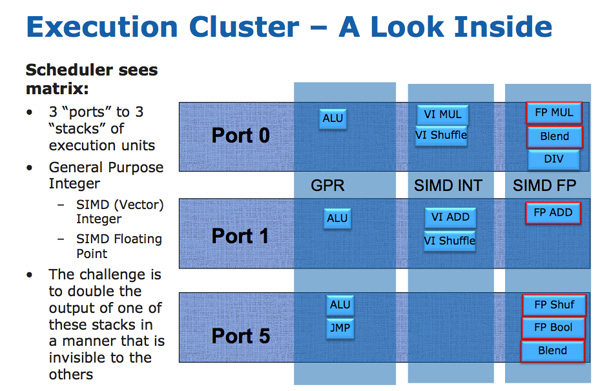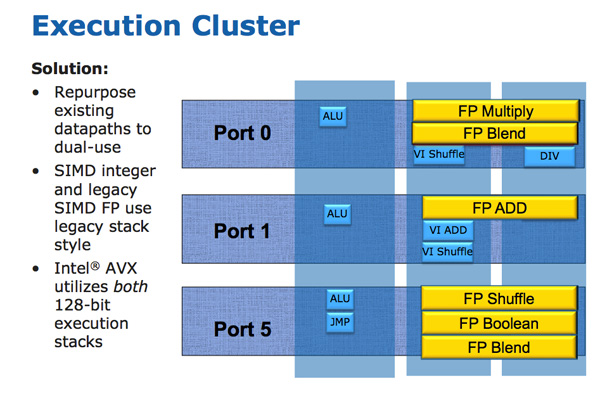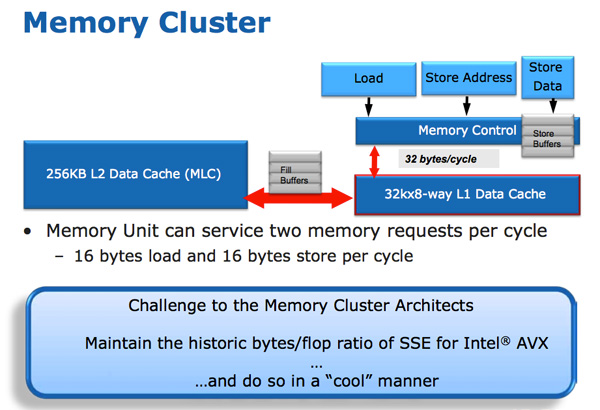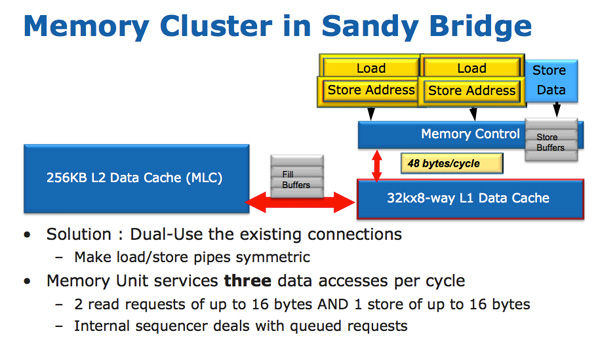Intel's Sandy Bridge Architecture Exposed
by Anand Lal Shimpi on September 14, 2010 4:10 AM EST- Posted in
- CPUs
- Intel
- Sandy Bridge
A Physical Register File
Just like AMD announced in its Bobcat and Bulldozer architectures, in Sandy Bridge Intel moves to a physical register file. In Core 2 and Nehalem, every micro-op had a copy of every operand that it needed. This meant the out-of-order execution hardware (scheduler/reorder buffer/associated queues) had to be much larger as it needed to accommodate the micro-ops as well as their associated data. Back in the Core Duo days that was 80-bits of data. When Intel implemented SSE, the burden grew to 128-bits. With AVX however we now have potentially 256-bit operands associated with each instruction, and the amount that the scheduling/reordering hardware would have to grow to support the AVX execution hardware Intel wanted to enable was too much.

A physical register file stores micro-op operands in the register file; as the micro-op travels down the OoO engine it only carries pointers to its operands and not the data itself. This significantly reduces the power of the out of order execution hardware (moving large amounts of data around a chip eats tons of power), it also reduces die area further down the pipe. The die savings are translated into a larger out of order window.
The die area savings are key as they enable one of Sandy Bridge’s major innovations: AVX performance.
The AVX instructions support 256-bit operands, which as you can guess can eat up quite a bit of die area. The move to a physical register file enabled Intel to increase OoO buffers to properly feed a higher throughput floating point engine. Intel clearly believes in AVX as it extended all of its SIMD units to 256-bit wide. The extension is done at minimal die expense. Nehalem has three execution ports and three stacks of execution units:

Sandy Bridge allows 256-bit AVX instructions to borrow 128-bits of the integer SIMD datapath. This minimizes the impact of AVX on the execution die area while enabling twice the FP throughput, you get two 256-bit AVX operations per clock (+ one 256-bit AVX load).

Granted you can’t mix 256-bit AVX and 128-bit integer SSE ops, however remember SNB now has larger buffers to help extract more ILP.
The upper 128-bits of the execution hardware and paths are power gated. Standard 128-bit SSE operations will not incur an additional power penalty as a result of Intel’s 256-bit expansion.
AMD sees AVX support in a different light than Intel. Bulldozer features two 128-bit SSE paths that can be combined for 256-bit AVX operations. Compared to an 8-core Bulldozer a 4-core Sandy Bridge has twice the 256-bit AVX throughput. Whether or not this is an issue going forward really depends on how well AVX is used in applications.
The improvements to Sandy Bridge’s FP performance increase the demands on the load/store units. In Nehalem/Westmere you had three LS ports: load, store address and store data.

In SNB, the load and store address ports are now symmetric so each port can service a load or store address. This doubles the load bandwidth which is important as Intel doubled the peak floating point performance in Sandy Bridge.

There are some integer execution improvements in Sandy Bridge, although they are more limited. Add with carry (ADC) instruction throughput is doubled, while large scale multiplies (64 * 64) see a ~25% speedup.











62 Comments
View All Comments
FXi - Tuesday, September 14, 2010 - link
Only thing I am saddened by is that hybrid graphics apparently won't be "working" on the mobile high end chipset with the dual pci-e x8 lanes. It's extremely nice to have 2x a good modern mobile GPU, but still be able to switch to the Intel built in GPU when you want longer battery life on the road.That ability, in the 2920 was something I was truly hoping for.
The rest of its abilities are quite nice and very welcome. USB 3 really is something to be sure they didn't miss. But otherwise kudos Intel.
Drazick - Tuesday, September 14, 2010 - link
Anand, few questions with your permission:I wonder If we could use a Discrete Graphics Card and enable the Media Engine.
What about the DMI bus, Hasn't it become a bottleneck with SSD Drives and USB3?
Does Intel have planes to address it?
Thanks.
EricZBA - Tuesday, September 14, 2010 - link
Someone please release a decent 13.3 inch laptop using Sandy Bridge please.bitcrazed - Tuesday, September 14, 2010 - link
I have a sneaking suspicion that Intel will be at the core of Apple's next laptop platform refresh with both SandyBridge and LightPeak.Apple's MacBook lineup is starting to feel a little pressure from the other PC laptop vendors who are starting to produce some nicely designed tin and will need to stay current in order to continue to sell their products at such high premiums.
I'm imagining the next MacBook Pro lineup to offer 13" MBP's running i3 2120's and the 15" and 17" models running i5 2400/2500's or i7 2600's.
Apple already have their own dynamic integrated/discrete GPU switching technology (as do nVidia) and can make even better use of SB's integrated GPU augmented by a modest discrete GPU to deliver the performance that most users need but with much reduced power drain.
So how to differentiate themselves? LightPeak. Apple was the instigator of LightPeak to start with and Intel claimed at CES 2010 that it'd appear around a year later. That's next spring.
One thing's for sure: 2011 is going to be a VERY interesting year for new laptop and desktop devices :)
name99 - Tuesday, September 14, 2010 - link
LightPeak WITHOUT USB3 will go over like a lead zeppelin.There are already plenty of USB3 peripherals available. I have never in my life seen a LightPeak peripheral, or even a review or sneak peek of one. Light Peak is coming, but I'm not sure that 2011 is its year.
The rate at which CPU speeds now increases is low enough that very few buyers feel any sort of pressure to upgrade the machine they bough 3 years ago. Apple can't deal with that by simply offering new iMacs and MacBooks with the newest Intel offering, since no normal person is much excited by another 10% CPU boost.
They have done an adequate job of dealing with this so far by boosting battery life, something (some) portable users do care about.
They have done a mixed job of making more cores, hyperthreading and better GPUs a reason to upgrade. We have some low-level infrastructure in Snow Leopard, but we have fsckall user level apps that take advantage of this. Where is the multi-threaded Safari? Where is the iTunes that utilizes multiple cores, and the GPU for transcoding audio? Does FileVault use AES-NI --- apparently not.
But Apple has done an truly astonishingly lousy job of tracking the one remaining piece of obvious slowness --- IO. Still no TRIM, still no eSATA, still no USB3.
My point is that I don't know the Apple politics, but I do know that they are doing a very very bad job of shipping machines that compel one to upgrade. There is no need for me to upgrade my 3+yr old Penryn iMac, for example --- I'd get a replacement with more cores (not used by any of my software), a better GPU (but what I have plays video just fine), and most importantly, NO FASTER IO.
Adding LightPeak to this mix without USB3 is not going to help any. People are still going to hold off on upgrades until USB3 is available, and no-one is going to rush to buy a LightPeak system so that they can then NOT run any of the many unavailable LightPeak peripherals on the shelves at Fry's.
NaN42 - Tuesday, September 14, 2010 - link
On page 3: "Compared to an 8-core Bulldozer a 4-core Sandy Bridge has twice the 256-bit AVX throughput."WTF? 8*128 = 4*256. Based on the premise that the fp-scheduler of one Bulldozer module (two cores) can schedule e.g. one add and one mul avx-instruction per clock cycle, they have the same throughput. I think both architectures will have a delay for e.g. shuffling ymm-registers (compared to current xmm-instructions) because data has to be exchanged between different pipelines/ports (Hopefully the picture provided by Intel is correct). Perhaps the delay is smaller in Sandy Bridge cores. I expect some delays when one mixes floating-point and integer instructions on Sandy Bridge. (Currently I don't know, whether there exists a VEX prefix for xmm integer instructions. If there's no VEX prefix the delays will be great on both platforms.)
gvaley - Tuesday, September 14, 2010 - link
"...you get two 256-bit AVX operations per clock.""AMD sees AVX support in a different light than Intel. Bulldozer features two 128-bit SSE paths that can be combined for 256-bit AVX operations. "
So it's actually 8*256 = 4*2*256. At least this is how I see it.
NaN42 - Tuesday, September 14, 2010 - link
"So it's actually 8*256 = 4*2*256. At least this is how I see it. "Ok, my calculation was a bit different. 4*2*256 will be true, but only if you mix additions and multiplications. Whether AMD is 8*2*128 depends on the fp-scheduler (based on the premise that one SIMD unit consists of a fmul, fadd and fmisc unit or something similar)
NaN42 - Tuesday, September 14, 2010 - link
... one can do another floating point operation which goes through port 5, but the peak performance of additions and multiplications is more relevant in applications.Spacksack - Tuesday, September 14, 2010 - link
I think you are right. I would think bulldozer can manage the same theoreticakl throughput by issuing one combined FMA instruction (16 flop) / clock and module.More importantly Bulldozer will achieve hight throughput for all the existing SSE code by having two independent FMA units. I have no idea how Anand could make such a mistake.